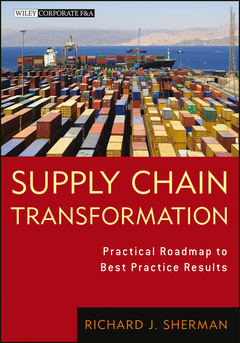Description
Supply Chain Transformation
Practical Roadmap to Best Practice Results
Wiley Corporate F&A Series
Author: Sherman Richard J.
Language: English
Subject for Supply Chain Transformation:
Keywords
Global supply chain, sourcing options, supply chains, best practices supply chains, RJ Sherman, systems thinking, demand management, organizational culture, production, logistics, collaboration, operations excellence, managing change, vision, strategy, metrics, performance improvement, Lean, Six Sigma, SCOR, journey, system dynamics, channels, marketing, financial measures, shareholder value, supply network, enterprise applications, technology, Rich Sherman, Richard J Sherman, learning organization, market dynamics
208 p. · 18.5x26.2 cm · Hardback
Description
/li>Contents
/li>Biography
/li>
Much is being written about global supply chain and sourcing options emerging in today's marketplace. Transforming supply chain management to achieve operations excellence is a mandate for many companies globally. Supply Chain Transformation walks you through this potentially difficult process and gets you started on the journey. Much more than just a how-to book, it's a why-to book that is as compelling for any business person as it is for supply chain management professionals. This book provides an invaluable road map to companies looking to transform their supply chains and organizations to achieve best practice results, beginning with guidance on how to make the case for change. Change is inevitable; growth is optional.
- Includes real world cases and illustrations
- Offers a step-by-step road map to transforming your supply chain
- Explains how to obtain "senior management" commitment to transformation
- Covers sourcing, production, and logistics process integration points with product development, marketing, sales, and finance processes as well as emerging technologies (RFID, Cloud computing, telematics, ERP, GPS/LBS & others)
One of the biggest hurdles to supply chain transformation is overcoming a culture that is resistant to change. Supply Chain Transformation helps you understand the cultural resistance and evaluate where change is needed most, and then develop the game plan for overcoming resistance to achieve best practice results.
Foreword xi
Preface xiii
Acknowledgments xvii
Chapter 1: Change is Inevitable, Growth is Optional 1
Globalization Changes the Game 3
Paradigms Drive Organizational Behavior and Culture 5
Assessing Your Company’s Culture 7
Levels of Cultural Maturity 9
Building a Case for Change 14
Paradigms Can Encourage or Constrain Innovation 16
Notes 18
Chapter 2: Putting the Business in Perspective 19
Defining and Understanding Business Objectives 21
Defining the Business within the Context of the Market 24
Developing Your Vision 25
Adding SWOT Analysis Puts the Business in Perspective 29
Principle of Creative Tension 32
Notes 34
Chapter 3: Market Drivers and the Dynamics of Change 35
Supply Chain is Marketing: A Tool for Analyzing the Market Environment Impacting the Supply Chain 38
Scanning the Market Environment for Drivers of Change 40
Systems Thinking: Your Strategy for Managing in a Changing Market 43
Notes 52
Chapter 4: Business Structures are the Levers of Change 53
You Can’t Break Down the Silos: Collaboration is the Key 54
Understanding the Business Structures and Processes That Govern the Behavior of the Organization 57
Vertical and Horizontal Business Structures and Drivers 58
Everything That Gets Done Gets Done through a Process . . .Business Process Management 60
Chapter 5: If You’re Driven by Demand, You’re Probably Being Driven Crazy 69
What are the Demand Creation Structure Process Types? 73
Demand Creation Processes Impact Demand Fulfillment Behavior Dramatically 76
Guess What? The Forecast is Wrong, Deal with It 79
Forecasting is as Much about Art as It is about Science 82
Event-Driven Forecasting is a Best Practice Imperative 84
Extend Collaborative Processes to the Customer (and Supplier) 86
Note 89
Chapter 6: Supply Chain Management: A Pipeline of Opportunity 91
Understanding the Demand Fulfillment Structure 92
Major Operating Functions of the Demand Fulfillment Structure: Procurement, Production, and Logistics 94
Lean Six Sigma is Not an Option—It’s a Requirement 99
Leveraging Supply Chain Capability for Synchronization: Strategy, Planning, and Execution 103
Notes 119
Chapter 7: Okay, We Need Management Commitment; So, How Do We Get It? 121
Understanding the Demand Performance Structure 122
You Can’t Manage What You Can’t Measure 125
Process Types That Drive the Demand Performance Structure 130
What Keeps the CEO and CFO Up at Night? 131
How Does Operations (Supply Chain) Excellence Impact the Income Statement and Balance Sheet to Drive Return on Invested Capital? 134
Notes 140
Chapter 8: Technology Drives the Waves of Change 141
Scanning the Horizon for Technology Developments 142
What Emerging Technologies are Likely to Impact the Supply Chain? 143
How Does Technology Impact the Organization? 147
How Can Information Technology Enable Business Operations to Maximize Return? 149
Chapter 9: Making the Journey Happen 153
We Got Management Commitment, What Do We Do Now? 154
Developing an Operating Plan and Creating a Culture for Change 154
Benchmarking: Perception versus Reality 161
How Do We Eat the Elephant? Identifying Projects and Setting Priorities 162
Jump on the Bandwagon: Communicating the Game Plan and Building Operations Support 166
Note 167
Conclusion: Business As Usual Has Been Canceled, Now What? 169
References 175
About the Author 177
Index 179
RICHARD J. SHERMAN is an internationally recognized writer, researcher, and speaker on trends and issues in logistics, supply chain management, technology, marketing, and organizational change. He is currently serving as Director of Strategic Development for the Council of Supply Chain Management Professionals (CSCMP) and President of Gold & Domas Research, serving corporate members worldwide. As a research director, he successfully launched the supply chain management advisory services for AMR Research and was a leading member of the team that developed the SCOR model and founded the Supply Chain Council. He is a frequent contributor of articles related to logistics and supply chain management, and speaks at conferences, symposiums, and universities.
These books may interest you

Basics of Supply Chain Management 214.69 €



